Effect of Alloying and Microalloying Elements on Carbides of High-Speed Steel: An Overview
Abstract
1. Introduction
2. Types of Carbides in High-Speed Steel
3. Effect of Alloying on Carbides in High-Speed Steel
3.1. Carbon
3.2. Tungsten and Molybdenum
3.3. Chromium
3.4. Vanadium
3.5. Cobalt
3.6. Silicon and Aluminum
3.7. Summary of Alloying
4. Effects of Microalloying on Carbides in High-Speed Steel
4.1. Nitrogen
4.2. Boron
4.3. Magnesium
4.4. Niobium
4.5. Titanium
4.6. Rare Earth
4.7. Summary of Microalloying
5. Outlook
Author Contributions
Funding
Data Availability Statement
Conflicts of Interest
References
- Chaus, A.S.; Dománková, M. Unknown high-speed steel. Mater. Lett. 2021, 292, 129653. [Google Scholar] [CrossRef]
- Wang, Q.M.; Cheng, G.G.; Huang, Y. Morphological characteristics and precipitation mechanism of large-sized carbides in M2 high-speed steel. Iron Steel 2018, 53, 65–71. [Google Scholar] [CrossRef]
- Liu, Z.Q.; Cao, H.J.; Zheng, X.P.; Ma, B. Research and application of high vanadium high speed steel. Hot Working Technology. 2014, 43, 23–26. [Google Scholar] [CrossRef]
- Liang, W.; Li, J.; Yan, W.; Shi, C.B.; Zhang, J. Evolution behavior and comparison of carbide in ingot casting and ESR M2 high speed steel. China Metall. 2020, 30, 28–34. [Google Scholar] [CrossRef]
- Li, Z.C.; Chen, Y.M.; Chen, X.R.; Zhong, H.G.; Li, L.J.; Zhai, Q.J. Thermal simulation of carbide and macrosegregation in continuous casting M2 high-speed steel. J. Iron Steel Res. 2023, 35, 1228–1240. [Google Scholar] [CrossRef]
- Dai, Y.H.; Man, T.H.; Li, P.; Xu, L.Q.; Liu, Y.; Wei, X.C. Effect of Rare Earth Alloying on High-Carbon and High-Alloy Tool and Die Steel. Mater. Rep. 2023. Available online: http://kns.cnki.net/kcms/detail/50.1078.TB.20231209.1355.002.html (accessed on 11 December 2023).
- Chen, J.Y.; Zhu, L.M.; Yin, Z.H.; Xiao, J.; Liu, H.N.; Zhong, H.G. Production and quality control technologies for high-speed steel. Shanghai Met. 2022, 44, 8–14+23. [Google Scholar] [CrossRef]
- Zhou, X.F.; Liu, D.; Zhu, W.L.; Fang, F.; Tu, Y.Y.; Jiang, J.Q. Morphology, microstructure and decomposition behavior of M2C carbides in high speed steel. J. Iron Steel Res. Int. 2017, 24, 43–49. [Google Scholar] [CrossRef]
- Kazunori, K.; Shinya, I.; Hirofumi, M.; Yuji, K. Effect of MC Type Carbides on Wear Resistance of High Wear Resistant Cast Iron Rolls Developed for Work Rolls of Hot Strip Mills. ISIJ Int. 2021, 61, 2597–2604. [Google Scholar] [CrossRef]
- Ye, H.L.; Wang, Q.; Liu, B.; Li, Z.M.; Chen, X.; Feng, B.D. Research on morphologies and stability of eutectic carbide in M2 high speed steel. Hot Work. Technol. 2022, 51, 83–85. [Google Scholar] [CrossRef]
- Cheng, X.L.; Hou, J.Q.; Fu, H.G. Microstructure evolution and wear resistance of boron-bearing high speed steel roll. Arch. Metall. Mater. 2022, 67, 113–119. [Google Scholar] [CrossRef]
- Yin, F.X.; Su, M.; Ji, F.; Tian, Q.C.; Bai, Y.G.; Feng, J.H.; Xiao, Z.X. Effect of melting rate on microsegregation and primary MC carbides in M2 high-speed steel during electroslag remelting. China Foundry 2021, 18, 163–169. [Google Scholar] [CrossRef]
- Zhou, X.F.; Fang, F.; Li, F.; Jiang, J.Q. Morphology and microstructure of M2C carbide formed at different cooling rates in AISI M2 high speed steel. J. Mater. Sci. 2011, 46, 1196–1202. [Google Scholar] [CrossRef]
- Zheng, L.C.; Yan, B.Q.; Lou, J.; Li, H.B.; Jiang, Z.H. Formation Behavior of M2C and M6C Eutectic Carbides in M42 High-Speed Steel. ISIJ Int. 2023, 63, 294–302. [Google Scholar] [CrossRef]
- Liu, W.F.; Guo, Y.F.; Cao, Y.F.; Wang, J.Q.; Hou, Z.Y.; Sun, M.X.; Xu, B.; Li, D.Z. Transformation behavior of primary MC and M2C carbides in Cr4Mo4V steel. J. Alloys Compd. 2022, 889, 161755. [Google Scholar] [CrossRef]
- Yao, J.; Man, T.H.; Liu, Y.; Zhu, X.D.; Dong, H. Effect of continuous casting on segregation and carbide of M2 high speed steel. China Metall. 2023, 33, 77–84. [Google Scholar] [CrossRef]
- Zheng, T.X.; Li, W.Q.; Qi, W.T.; Xia, Z.B.; Li, Q.; Shen, Z.; Guo, Y.F.; Zhong, Y.B.; Wang, H.; Wang, Q.L. Morphology transition of eutectic carbide assisted by thermoelectric magnetic force during the directional solidification of M2 high-speed steel. Ironmak. Steelmak. 2021, 48, 885–892. [Google Scholar] [CrossRef]
- Luo, Y.W.; Guo, H.J.; Guo, J. Effect of cooling rate on the transformation characteristics and precipitation behaviour of carbides in AISI M42 high-speed steel. Ironmak. Steelmak. 2019, 46, 698–704. [Google Scholar] [CrossRef]
- Ma, J.Y.; Li, H.B.; Wang, H.J.; Jiao, W.C.; Wan, X.D.; Liu, S.Q. Effect of cryogenic treatment on microstructure and properties of high-nitrogen M42 high-speed steel. J. Iron Steel Res. 2023, 35, 1282–1290. [Google Scholar] [CrossRef]
- Qin, Z.; Xin, R.; Zhang, J.; Lan, H.; Xue, Q. Effect of preheat treatment on carbide morphologies of cast HSS. Hot Work. Technol. 2014, 43, 201–203. [Google Scholar] [CrossRef]
- Lin, Y.H.; Li, H.; Ju, J.; Jiang, C.C.; Lei, Y.P.; Fu, H.G. Effect of boron content on high-temperature oxidation resistance of B-bearing high-speed steel. Surf. Rev. Lett. 2020, 27, 12. [Google Scholar] [CrossRef]
- Zhang, Y.; Ma, D.S.; Liu, J.H.; Chen, Z.Z.; Yong, Q.L. Microstructure and mechanical properties of W4Mo2Cr4VNb steel. J. Iron Steel Res. 2008, 20, 36–40. [Google Scholar] [CrossRef]
- Fu, H.G.; Liu, X.N.; Yang, Y.W.; Cheng, X.L.; Qu, Y.H. Effect of heat treatment on microstructure and properties of high-boron high-speed steel. Trans. Indian Inst. Met. 2018, 71, 2423–2432. [Google Scholar] [CrossRef]
- Wei, S.Z.; Xu, L.J. The effect of heat treatment on the microstructure of cast high tungsten high-speed steel. Acta Met. Sin. 2020, 56, 523–538. [Google Scholar] [CrossRef]
- Chen, J.B.; Liu, Y.F.; Wang, Y.J.; Xu, R.; Shi, Q.Y.; Chen, J.S.; Wu, Y.P. Design and Optimization of Heat Treatment Process Parameters for High-Molybdenum-Vanadium High-Speed Steel for Rolls. Materials 2023, 16, 7103. [Google Scholar] [CrossRef] [PubMed]
- Bai, L.N.; Cui, C.X.; Zhang, J.J.; Zhao, L.C.; Zheng, G.X.; Cui, S. Enhanced grain refinement of W18Cr4V high-speed steel using in situ TiN–Nb–Cr@Graphene/Fe nanocomposite inoculant. Steel Res. Int. 2021, 92, 2100094. [Google Scholar] [CrossRef]
- Ikawa, Y.; Itami, T.; Kumagai, K.; Kawashima, Y.; Leatham, A.G.; Coombs, J.S.; Brooks, R.G. Spray Deposition Method and Its Application to the Production of Mill Rolls. ISIJ Int. 1990, 30, 756–763. [Google Scholar] [CrossRef][Green Version]
- Wu, Z.J.; Chen, Z.G.; Xiang, Y.; Wei, X.; Zhang, J.S. Effect of small account of Ce addition on microstructure and mechanical properties of high-boron high speed steel. Chin. J. Nonferrous Met. 2013, 23, 1289–1294. [Google Scholar] [CrossRef]
- Wei, S.Z.; Zhu, J.H.; Xu, L.J.; Long, R. Effects of carbon on microstructures and properties of high vanadium high-speed steel. Mater. Des. 2006, 27, 58–63. [Google Scholar] [CrossRef]
- Shao, K.Z.; Wei, S.Z.; Long, R.; Ni, F.; Peng, T. The Effect of Carbon on the Solidification Process of High Vanadium High Speed Steel. Foundry Technol. 2005, 11, 30–34. [Google Scholar] [CrossRef]
- Cao, Y.L.; Zhao, Z.R.; Ma, C.S.; Li, G.Q. Precipitation Behavior and Elemental Distribution of MC Carbides in High Carbon and Vanadium High-Speed Steel. J. Mater. Eng. Perform. 2022, 31, 4444–4458. [Google Scholar] [CrossRef]
- Wu, W.D.; Xiong, X.; Liu, R.T.; Luan, H.Z.; Hao, Y.R. The effect of carbon content on the microstructure and properties of M2 high-speed steel prepared by elemental powder method. Mater. Sci. Eng. Powder Metall. 2019, 24, 273–281. [Google Scholar] [CrossRef]
- Xu, L.J.; Zhou, H.; Wei, S.Z. Crystal structure and interface feature of carbide in high speed steel with high tungsten content. Trans. Mater. Heat Treat. 2016, 37, 123–128. [Google Scholar] [CrossRef]
- Chaus, A.S.; Porubski, Y. Effect of modifying tungsten additions on formation of primary structure of R6M5-type high-speed steel. Phys. Met. Metall. 2012, 113, 1068–1078. [Google Scholar] [CrossRef]
- Šuštaršič, B.; Kosec, L.; Kosec, M.; Podgornik, B.; Dolinsek, S. The influence of MoS2 additions on the densification of water-atomized HSS powders. J. Mater. Process. Technol. 2006, 173, 291–300. [Google Scholar] [CrossRef]
- Yang, W.Y.; Xie, Z.B.; Wang, K.; Wang, Z.Y.; Liang, J.B.; Shao, Q.L. Study on rare earth modification of carbide structure of high speed steel. Hebei Metall. 2021, 11, 32–37+54. [Google Scholar] [CrossRef]
- Frisk, K.; Bratberg, J.; Markström, A. Thermodynamic modelling of the M6C carbide in cemented carbides and high-speed steel. Calphad 2005, 29, 91–96. [Google Scholar] [CrossRef]
- Zhang, J.W.; Zhao, Z.G.; Wang, W.X.; Wang, Y.T. Comparison of the Microstructure of M2 Steel Fabricated by Continuous Casting and with a Sand Mould. Metals 2019, 9, 560. [Google Scholar] [CrossRef]
- Hao, Y.R.; Liu, R.T.; Xiong, X. Effect of vanadium carbide on sintering properties and microstructure evolution of powder high speed steel. J. Northwestern Polytech. Univ. 2020, 38, 838–845. [Google Scholar] [CrossRef]
- Wang, Z.G. Effect of vanadium content on the microstructure and properties of W6Mo5Cr4Vx high-speed steel for bit. Iron Steel Vanadium Titan. 2021, 42, 139–143. [Google Scholar] [CrossRef]
- Xu, Q. Research on the Application of VN Alloy in High-Speed Steel. Master’s Thesis, Kunming University of Science and Technology, Kunming, China, 2005; pp. 27–31. [Google Scholar]
- Li, L.J. Study on the Effect of Cobalt Content on the Microstructure and Properties of M2 High-Speed Steel. Master’s Thesis, Kunming University of Science and Technology, Kunming, China, 2021; pp. 20–28. [Google Scholar]
- Chi, H.X.; Ma, D.S.; Zhan, L.C.; Xu, H.X.; Zhu, W.L. Effect of heat treatment on microstructure and mechanical property of a P/M high speed steel W6Mo5Cr4V3Co8. Trans. Mater. Heat Treat. 2012, 33, 105–109. [Google Scholar] [CrossRef]
- Moon, H.K.; Lee, K.B.; Kwon, H. Influences of Co addition and austenitizing temperature on secondary hardening and impact fracture behavior in P/M high speed steels of W–Mo–Cr–V(–Co) system. Mater. Sci. Eng. A 2007, 474, 328–334. [Google Scholar] [CrossRef]
- Toptop, G.; Kisasoz, A.; Karaaslan, A. Effect of alloying elements on the tooling capabilities of high speed steels fabricated by powder metallurgy. Mater. Test. 2013, 55, 43–46. [Google Scholar] [CrossRef]
- Wang, W.Q.; Pan, F.S.; Wu, L.Z.; Tang, A.T.; Liu, T.T. Effect of silicon on eutectic carbides in as-heated M2 high speed steel. J. Chongqing Univ. 2011, 34, 44–49. [Google Scholar] [CrossRef]
- Pan, F.S.; Wang, W.Q.; Tang, A.T.; Wu, L.Z.; Liu, T.T.; Cheng, R.J. Phase transformation refinement of coarse primary carbides in M2 high speed steel. Prog. Nat. Sci. Mater. Int. 2011, 21, 180–186. [Google Scholar] [CrossRef]
- Li, Y.J.; Jiang, Q.C.; He, Z.M.; Zhao, Y.G.; Ge, L.H. The effect of Al on the solidification process of M2 high-speed steel. CJMR 1997, 2, 216–218. [Google Scholar]
- Yang, Y.W.; Fu, H.G.; Wang, K.M.; Lei, Y.P.; Zhu, L.L.; Jiang, L. Effect of aluminum on phase diagram and solidification microstructure of high boron high speed steel. Mater. Heat Treat. 2016, 37, 48–54. [Google Scholar] [CrossRef]
- Pant, G.; Sonia, P.; Kumar, S.H. Investigation of the use of micro-alloy and as-cast micro-alloy steel in automotive application. IOP Mater. Sci. Eng. 2021, 1116, 012018. [Google Scholar] [CrossRef]
- Klemm-Toole, J.; Benz, J.; Thompson, S.W.; Findley, K.O. A quantitative evaluation of microalloy precipitation strengthening in martensite and bainite. Mater. Sci. Eng. 2019, 763, 138145. [Google Scholar] [CrossRef]
- Zhang, L.; Kannengiesser, T. Influence of microalloy design on heat-affected zone toughness of S690QL steels. Weld. World 2018, 62, 339–350. [Google Scholar] [CrossRef]
- Taylor, T.; Fourlaris, G.; Clough, A. Effect of carbon and microalloy additions on hot-stamped boron steel. Mater. Sci. Technol. 2017, 33, 1964–1977. [Google Scholar] [CrossRef]
- Xiong, W.M.; Song, R.B.; Yu, P.; Liu, Z.J.; Qin, S.; Zhang, Y.C.; Quan, S.Y.; Huo, W.F.; Zhao, Z.Y.; Su, S.R.; et al. Hot deformation behavior of V–Ti microalloy Steels. Steel Res. Int. 2020, 92, 2000225. [Google Scholar] [CrossRef]
- Zhang, H.; Zhou, M.; Tang, J.P.; Cao, J.; Wei, X.C.; Wang, W.R.; Ren, J.A. Correlation of wear resistance with carbides for Cr12MoV steel. Shanghai Met. 2021, 43, 42–49. [Google Scholar] [CrossRef]
- Wang, J.; Shi, H.S.; Yin, J.L.; Zhang, J.G. Effect of alloy element on microstructure of spray forming ultra high carbon steel. Shanghai Met. 2011, 33, 37–40+44. [Google Scholar] [CrossRef]
- Ueda, Y.; Wade, N.; Kawada, S. Graphite shape and eutectic cell structure of cast iron with incompletely spheroidal graphite. J. Jpn. Foundrymen’s Soc. 1974, 46, 212–217. [Google Scholar] [CrossRef]
- Guo, E.J.; Song, L.; Wang, L.P. Effect of Ce-Mg-Si and Y-Mg-Si nodulizers on the microstructures and mechanical properties of heavy section ductile iron. J. Rare Earths 2014, 32, 738–744. [Google Scholar] [CrossRef]
- Chen, P.; Liu, Y.Z.; Ping, X.Z.; Li, W.; Yi, Y.L. Influence mechanism of Y addition on microstructure, adsorbability, mechanical properties of as-cast high speed steel. Mater. Sci. Eng. A 2023, 863, 144520. [Google Scholar] [CrossRef]
- Labrecque, C.; Gagné, M. Review ductile iron: Fifty years of continuous development. Can. Metall. Q. CMQ 1998, 37, 343–378. [Google Scholar] [CrossRef]
- Franzen, D.; Pustal, B.; Bührig-Polaczek, A. Influence of graphite-phase parameters on the mechanical properties of high-silicon ductile iron. Int. J. Met. 2023, 17, 4–21. [Google Scholar] [CrossRef]
- Soedarsono, J.W.; Soemardi, T.P.; Suharno, B.; Sulamet-Ariobimo, R.D. Effects of carbon equivalent on the microstructures of thin wall ductile iron. J. Mater. Sci. Eng. 2011, 5, 266–270. [Google Scholar] [CrossRef]
- Luo, Y.W.; Guo, H.J.; Sun, X.L.; Guo, J. Influence of the nitrogen content on the carbide transformation of AISI M42 high-speed steels during annealing. Sci. Rep. 2018, 8, 4328–4329. [Google Scholar] [CrossRef] [PubMed]
- Hara, R.; Yamamoto, M.; Ito, G.; Kamimiyada, K.; Narita, I.; Miyahara, H. Effect of nitrogen on the microstructure and hardness of high-carbon high-speed tool steel type alloys. Mater. Trans. 2016, 57, 1945–1951. [Google Scholar] [CrossRef]
- Halfa, H.; Eissa, M.; Fawakhry, K.; Mattar, T. Effect of nitrogen and niobium on the structure and secondary hardening of super hard high speed tool steel. Steel Res. Int. 2012, 83, 32–42. [Google Scholar] [CrossRef]
- Li, Y.J.; Jiang, Q.C.; Zhao, Y.G.; He, Z.M.; Zhong, X.Y. Influence of B on solidification structure of M2 high speed steel. J. Mater. Res. 1999, 13, 183–187. [Google Scholar]
- Yuan, Z.T.; Jiang, Y.H.; Li, L.; Feng, J. First-principles study on the phase stability and mechanical properties of boron carbides in boron-bearing high-speed steel. Sci. Adv. Mater. 2018, 10, 1475–1483. [Google Scholar] [CrossRef]
- Astini, V.; Prasetyo, Y.; Baek, E.R. Effect of boron addition on the microstructure and mechanical properties of 6.5% V-5% W high speed steel. Met. Mater. Int. 2012, 18, 923–931. [Google Scholar] [CrossRef]
- Tewary, U.; Paul, D.; Mehtani, H.K.; Bhagavath, S.; Alankar, A.; Mohapatra, G.; Sahay, S.S.; Panwar, A.S.; Karagadde, S.; Samajdar, I. The origin of graphite morphology in cast iron. Acta Mater. 2022, 226, 117660. [Google Scholar] [CrossRef]
- Duan, J.T.; Jiang, Z.Q.; Fu, H.G. Effect of RE-Mg complex modifier on structure and performance of high speed steel roll. J. Rare Earths 2007, 25, 259–263. [Google Scholar] [CrossRef]
- Zhang, Z.; Chang, K.H.; Chang, L.Z.; Chen, J.S.; Zheng, F.Z. The effect of Mg on carbides in M2 high speed tool steel. J. Iron Steel Res. 2019, 31, 1046–1052. [Google Scholar] [CrossRef]
- Dobrzański, L.A.; Zarychta, A.; Ligarski, M. High-speed steels with addition of niobium or titanium. J. Mater. Process. Technol. 1997, 63, 531–541. [Google Scholar] [CrossRef]
- Shahram, K. Effect of Ti and Nb on the formation of carbides and the mechanical properties in as-cast AISI-M7 high-speed steel. ISIJ Int. 2001, 41, 1502–1509. [Google Scholar] [CrossRef]
- Chaus, A.S.; Bogachik, M.; Uradnik, P. Structural transformations during heat treatment of W-Mo cast high-speed steel modified using titanium diboride. J. Phys. Met. Metallogr. 2011, 112, 470–479. [Google Scholar] [CrossRef]
- Chaus, A.S.; Dománková, M. Precipitation of secondary carbides in M2 high-speed steel modified with titanium diboride. J. Mater. Eng. Perform. 2013, 22, 1412–1420. [Google Scholar] [CrossRef]
- Fu, H.G.; Xiao, Q.; Kuang, J.C.; Jiang, Z.Q.; Xing, J.D. Effect of rare earth and titanium additions on the microstructures and properties of low carbon Fe-B cast steel. Mater. Sci. Eng. A 2007, 466, 160–165. [Google Scholar] [CrossRef]
- Fu, H.G.; Jiang, Z.Q.; Li, M.W.; Zhang, Y.; Xing, J.D. Investigations on structure and performance of high speed steel roll modified by titanium additions. Foundry 2007, 56, 590–593. [Google Scholar] [CrossRef]
- Li, Z.; Zhao, W.; Zhang, D.L.; Shan, Q.; Zhang, F.; Wang, X.Y. Influence of rare-earth element doping on interface and mechanical properties of WC particles reinforced steel matrix composites. Mater. Res. Express 2021, 8, 036512. [Google Scholar] [CrossRef]
- Wang, Y.G.; Liu, C.J. Agglomeration characteristics of various inclusions in Al-killed molten steel containing rare earth element. Metall. Mater. Trans. B 2020, 51, 2585–2595. [Google Scholar] [CrossRef]
- Wang, S.; Zheng, Z.B.; Zheng, K.H.; Long, J.; Wang, J.; Ren, Y.Y.; Li, Y.M. High temperature oxidation behavior of heat resistant steel with rare earth element Ce. Mater. Res. Express 2020, 7, 016571. [Google Scholar] [CrossRef]
- Wang, C.G.; Ma, R.Y.; Zhou, Y.T.; Liu, Y.; Daniel, E.F.; Li, X.F.; Wang, P.; Dong, J.H.; Ke, W. Effects of rare earth modifying inclusions on the pitting corrosion of 13Cr4Ni martensitic stainless steel. J. Mater. Sci. Technol. 2021, 93, 232–243. [Google Scholar] [CrossRef]
- Deng, X.T.; Misra, R.D.K.; Wang, Z.D.; Jiang, Y.Y. Microstructure and mechanical properties of low alloy ultra-high strength steel microalloyed with erium. Key Eng. Mater. 2021, 871, 53–58. [Google Scholar] [CrossRef]
- Wei, W.Z.; Wu, K.M.; Zhang, X.; Liu, J.; Qiu, P.; Cheng, L. In-situ characterization of initial marine corrosion induced by rare-earth elements modified inclusions in Zr-Ti deoxidized low-alloy steels. J. Mater. Res. Technol. 2020, 9, 1412–1424. [Google Scholar] [CrossRef]
- Wang, D. Effects of Rare Earth on the Microstructure and Properties of M35 High-Speed Steel. Ph.D. Thesis, Southeast University, Nanjing, China, 2005; pp. 41–51. [Google Scholar]
- Zhou, X.F.; Fang, F.; Tu, Y.Y.; Jiang, J.Q.; Zhu, W.L.; Yin, S.Y. Carbide refinement in M42 high speed steel by rare earth metals and spheroidizing treatment. J. Southeast Univ. (Engl. Ed.) 2014, 30, 445–448. [Google Scholar]
- Gu, J.B.; Li, J.Y.; Chang, R.J. Enhanced refinement of Cr23C6 by heterogeneous nucleation in annealed nitrogen-alloyed 4Cr5Mo2V die steel. Metall. Mater. Trans. A 2019, 50, 518–522. [Google Scholar] [CrossRef]
- Jiao, W.C.; Li, H.B.; Feng, H.; Jiang, Z.H.; Xia, L.F.; Zhang, S.C.; Zhu, H.C.; Wu, W. Evolutions of micro- and macrostructure by cerium treatment in as-Cast AISI M42 high-speed Steel. Metall. Mater. Trans. B 2020, 51, 2240–2251. [Google Scholar] [CrossRef]
- Ji, Y.P.; Li, Y.M.; Zhang, M.X.; Ren, H.P. Crystallography of the heterogeneous nucleation of δ-Ferrite on Ce2O2S particles during solidification of an Fe-4Si alloy. Metall. Mater. Trans. A 2019, 50, 1787–1794. [Google Scholar] [CrossRef]
- Zhou, X.F.; Yin, X.Y.; Fang, F.; Jiang, J.Q.; Zhu, W.L. Influence of rare earths on eutectic carbides in AISI M2 high speed steel. J. Rare Earths 2012, 30, 1075–1078. [Google Scholar] [CrossRef]
- Hufenbach, J.; Helth, A.; Lee, M.H.; Wendrock, H.; Giebeler, L.; Choe, C.Y.; Kim, K.H.; Kühn, U.; Kim, T.S.; Eckert, J. Effect of cerium addition on microstructure and mechanical properties of high-strength Fe85Cr4Mo8V2C1 cast steel. Mater. Sci. Eng. A 2016, 674, 366–374. [Google Scholar] [CrossRef]
- Wang, M.J.; Mu, S.M.; Sun, F.F.; Wang, Y. Influence of rare earth elements on microstructure and mechanical properties of cast high-speed steel rolls. J. Rare Earths 2007, 25, 490–494. [Google Scholar] [CrossRef]
- Boccalini, M., Jr.; Correa, A.V.O.; Goldenstein, H. Rare earth metal induced modification of γ-M2C, γ-M6C, and γ-MC eutectics in as cast M2 high speed steel. Mater. Sci. Technol. 1999, 15, 621–626. [Google Scholar] [CrossRef]
- Zelič, K.; Burja, J.; McGuiness, P.J.; Godec, M. Effect of rare earth elements on the morphology of eutectic carbides in AISI D2 tool steels: Experimental and modelling approaches. Sci. Rep. 2018, 8, 9233–9238. [Google Scholar] [CrossRef] [PubMed]
- Jia, C.C.; Zhang, W.L.; Hu, B.T.; Zhang, Z.H.; Gao, S.T.; Liu, B.W. Influence of rare earth elements on microstructure and mechanical properties of high speed steel. Powder Metall. Technol. 2017, 35, 416–421. [Google Scholar] [CrossRef]
- Chaus, A.S. Use of REM-Based Modifying Agents for Improving the Structure and Properties of Cast Tungsten-Molybdenum High-Speed Steels. Metal. Sci. Heat Treat. 2004, 46, 415–422. [Google Scholar] [CrossRef]
- Liu, B.L.; Lyu, Z.Q.; Feng, W.W.; Ren, T.Z.; Fu, W.T. Precipitation and decomposition behaviors of carbides in AISI M2 high-speed steel with nitrogen and mischmetal. J. Cent. South. Univ. 2017, 24, 782–788. [Google Scholar] [CrossRef]
- Wang, M.J.; Li, Y.M.; Wang, Z.X.; Bao, E. Effect of rare earth elements on the thermal cracking resistance of high speed steel rolls. J. Rare Earths 2011, 29, 489–493. [Google Scholar] [CrossRef]
- Li, Y.J.; Jiang, Q.C.; Zhao, Y.G.; He, Z.M.; Zhong, X.Y. Influence of cerium on solidification structure of M2 high speed steel. J. Chin. Soc. Rare Earths 1999, 17, 54–57. [Google Scholar] [CrossRef]
- Kunz, J.; Köhler, M.L.; Herzog, S.; Kaletsch, A.; Broeckmann, C. Influence of an increasing alloying content on the microstructure of a high-speed steel in the Laser-Powder Bed Fusion process. Steel Res. Int. 2021, 92, 2100438. [Google Scholar] [CrossRef]
- Guo, Y.F.; Qi, W.T.; Xia, Z.B.; Zhao, X.H.; Li, Q.; Liu, C.M.; Ding, B.; Shen, Z.; Zheng, T.X.; Zhong, Y.B. Morphology tailoring of metal pool and eutectic carbides in magnetic-controlled electroslag remelted M2 high-speed steel. J. Mater. Res. Technol. 2022, 16, 1122–1135. [Google Scholar] [CrossRef]
- Zhu, J.; Zhou, W.J.; Zhang, Z.H.; Xie, J.X. Composition, microstructure, and inclusion characteristics of H13 steel ingot by electroslag remelting with rare earth slag. J. Iron Steel Res. 2021, 33, 966–978. [Google Scholar] [CrossRef]
- Cao, Y.L.; Zhao, Z.R.; Wan, X.L.; Li, G.Q.; Jiang, Z.H.; Dong, Y.W. Carbide characteristics of high vanadium high-speed steel manufactured by electroslag remelting. ISIJ Int. 2022, 62, 1430–1438. [Google Scholar] [CrossRef]
- Shi, H.; Li, L.J.; Wang, H.Y.; Zhu, L.M.; Zhai, Q.J. Effect of PMO on rating and distribution of banded carbides in GCr15 steel bars. Shanghai Met. 2020, 42, 57–62+70. [Google Scholar] [CrossRef]
- Li, K.C.; Li, L.J.; Cai, C.Q.; Xu, Y.H.; Xu, H.; Zhai, Q.J. Effect of M-PMO on inclusion of HRB400EG thread steel continuous casting billet. Iron Steel 2023, 58, 58–68. [Google Scholar] [CrossRef]
- Liu, Y.J.; Xu, G.D.; Wang, Y.C.; Zhong, H.G.; Li, L.J.; Wang, B.; Zhai, Q.J. Effects of Pulse magneto-oscillation on GCr15 bearing steel continuous casting billet. J. Iron Steel Res. Int. 2022, 29, 144–150. [Google Scholar] [CrossRef]
- Liu, H.N.; Chen, Y.M.; Chen, X.R.; Li, L.J.; Zhai, Q.J. Effect of PMO on dendritic structure and carbide of high-speed steel. Iron Steel 2023. [Google Scholar] [CrossRef]
- Xu, H.; Li, L.J.; Cai, C.Q.; Zheng, Y.S.; Zhong, H.G.; Zhai, Q.J. Study on improving quality of continuous casting billet by using mould PMO. Shanghai Met. 2019, 41, 75–79. [Google Scholar] [CrossRef]
- Wang, Y.C.; Xu, R.J.; Zhong, H.G.; Xu, G.D.; Xu, Z.S.; Li, R.X.; Zhai, Q.J. Effects of pulsed magneto-oscillation on the homogeneity of low carbon alloy steel continuous casting round billet. Metals 2022, 12, 833. [Google Scholar] [CrossRef]
- Wei, R.X.; Zhang, H.; Li, R.X.; Chen, Y.Q.; Li, C.B.; Liu, H.N. Influence of PMO on solidification structure and central segregation of hard wire steel billet. China Metall. 2023, 33, 115–121. [Google Scholar] [CrossRef]
- Ji, S.; Zhang, L.F.; Wang, Y.; Chen, W.; Wang, X.D.; Zhang, J.Y. Effect of electromagnetic stirring on inclusions in continuous casting blooms of a gear steel. Metall. Mater. Trans. B 2021, 52, 2341–2354. [Google Scholar] [CrossRef]
- Li, P.C.; Zhang, G.F.; Yan, P.; Tian, N.; Feng, Z.H. Numerical and experimental study on carbon segregation in shaped billet of medium carbon steel with combined electromagnetic stirring. Materials 2023, 16, 7464. [Google Scholar] [CrossRef] [PubMed]
- Zhao, X.H.; Sun, Z.H.; Xia, Z.B.; Liu, C.M.; Shen, Z.; Ding, B.; Zheng, T.X.; Guo, Y.F.; Li, Q.; Zhong, Y.B. Morphology control of metal pool and eutectic carbides in electroslag remelted M2 HSS with an external axial static magnetic field. Metals 2023, 13, 912. [Google Scholar] [CrossRef]
- Chen, D.H.; Xu, X.F.; Zhao, Y.; Fu, X.G.; Wei, L.; Zhou, Y.C.; Wu, Z.C. Superior mechanical properties of M35 high-speed steel obtained by controlling carbide precipitation and distribution via electropulsing treatment. Mater. Sci. Eng. A 2023, 888, 145691. [Google Scholar] [CrossRef]


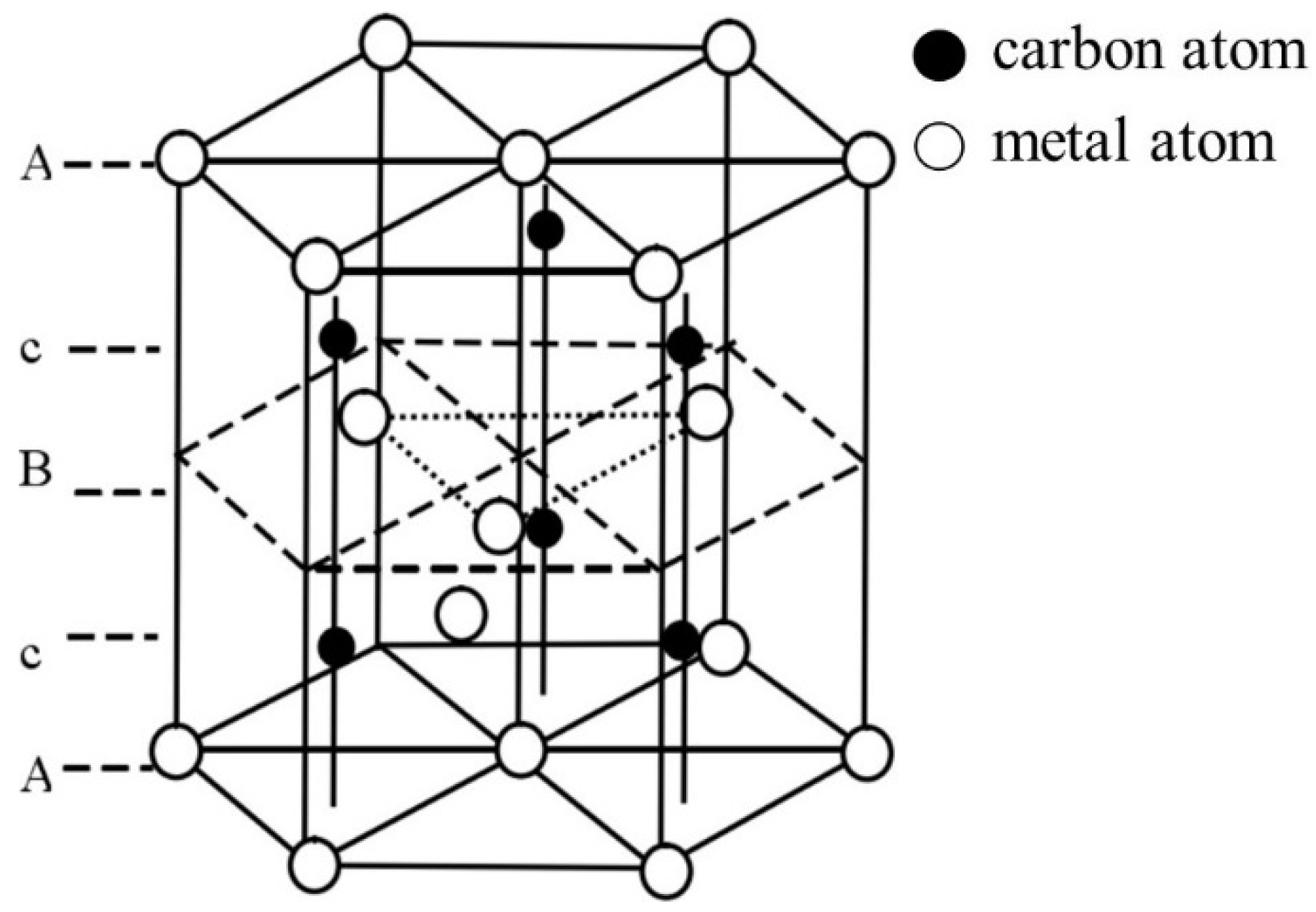
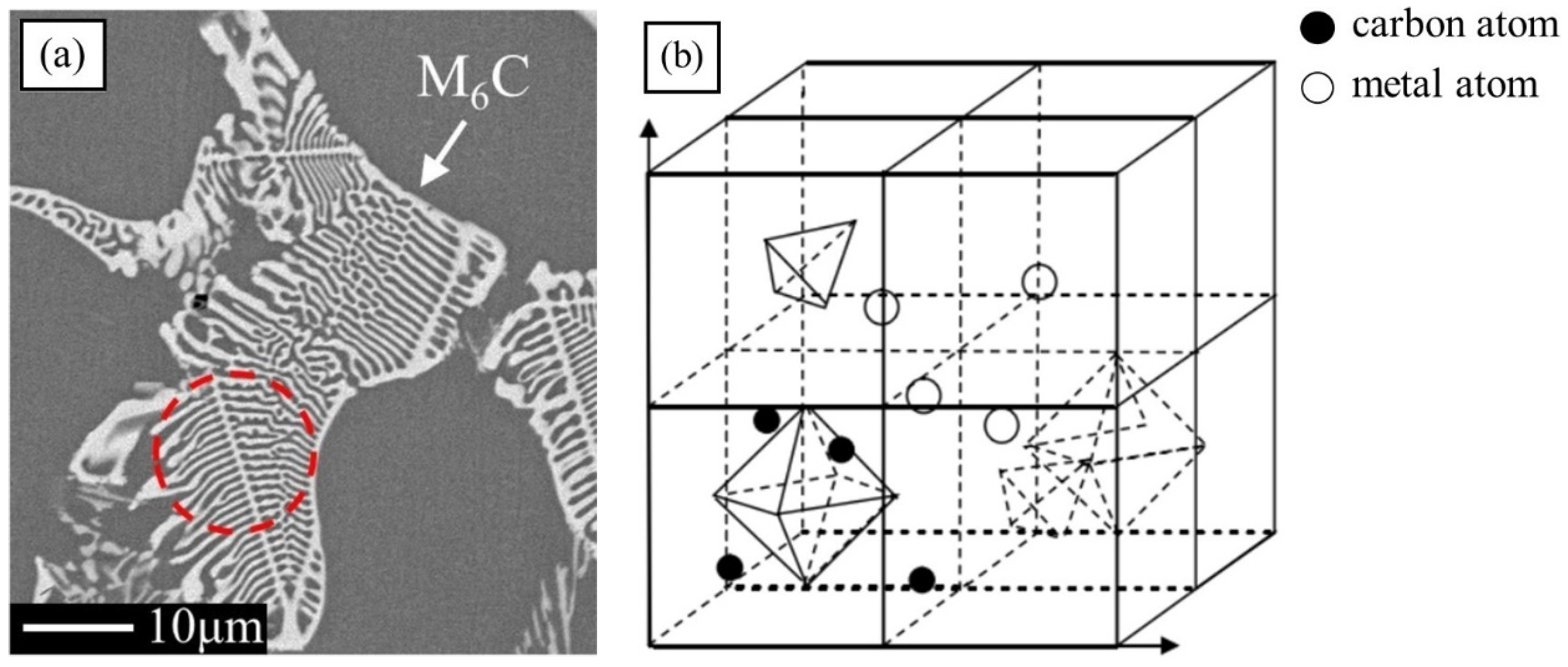
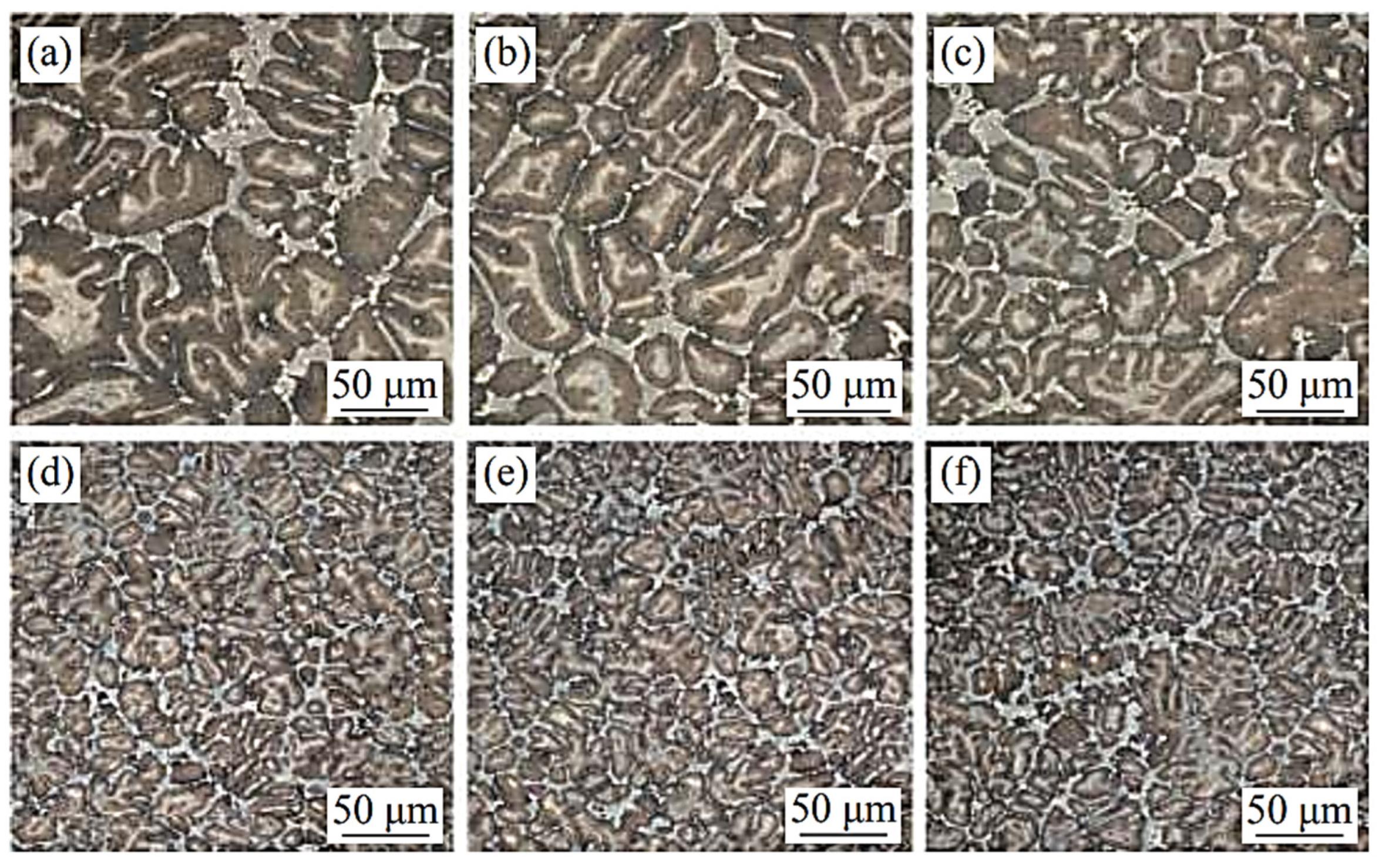
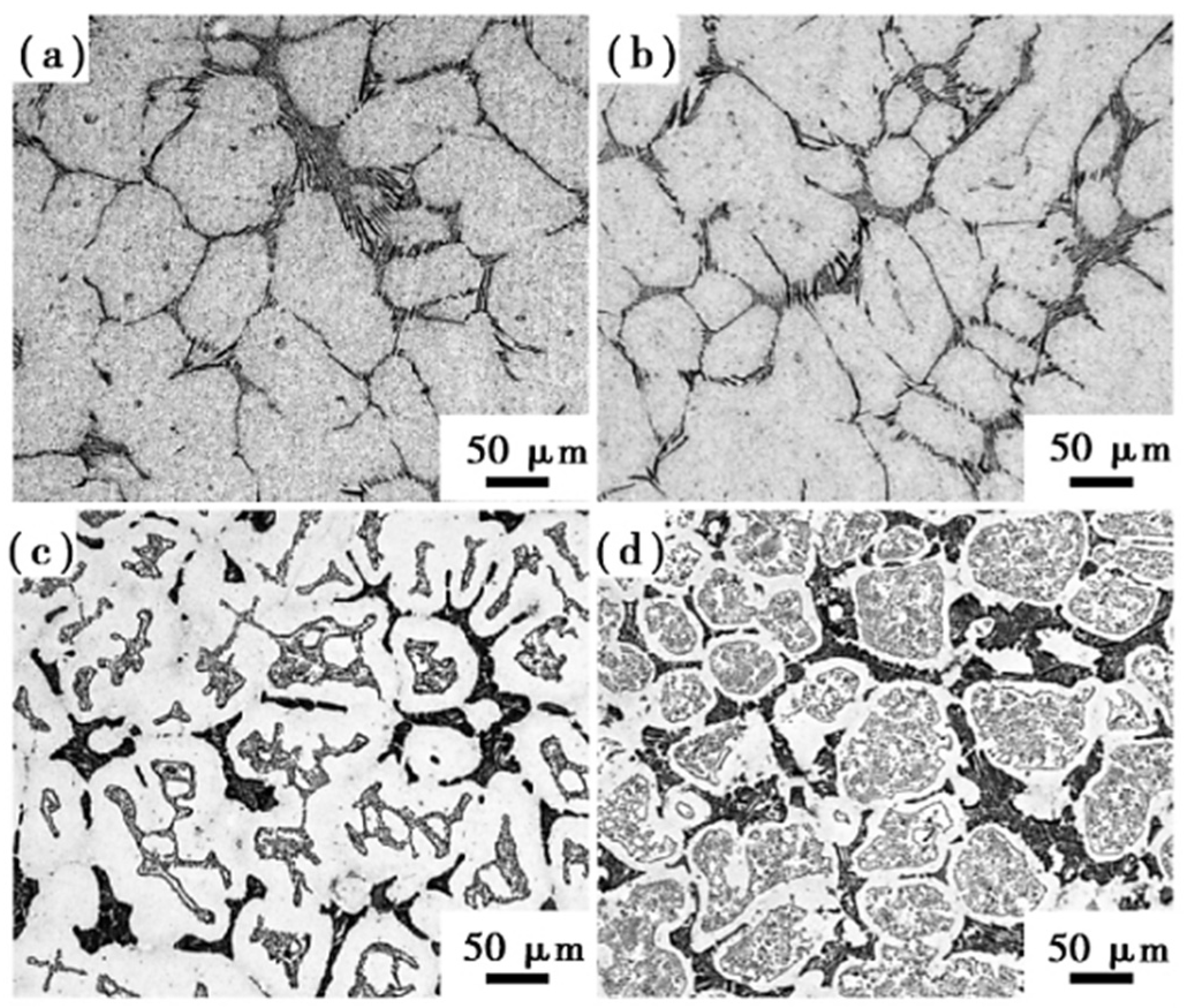
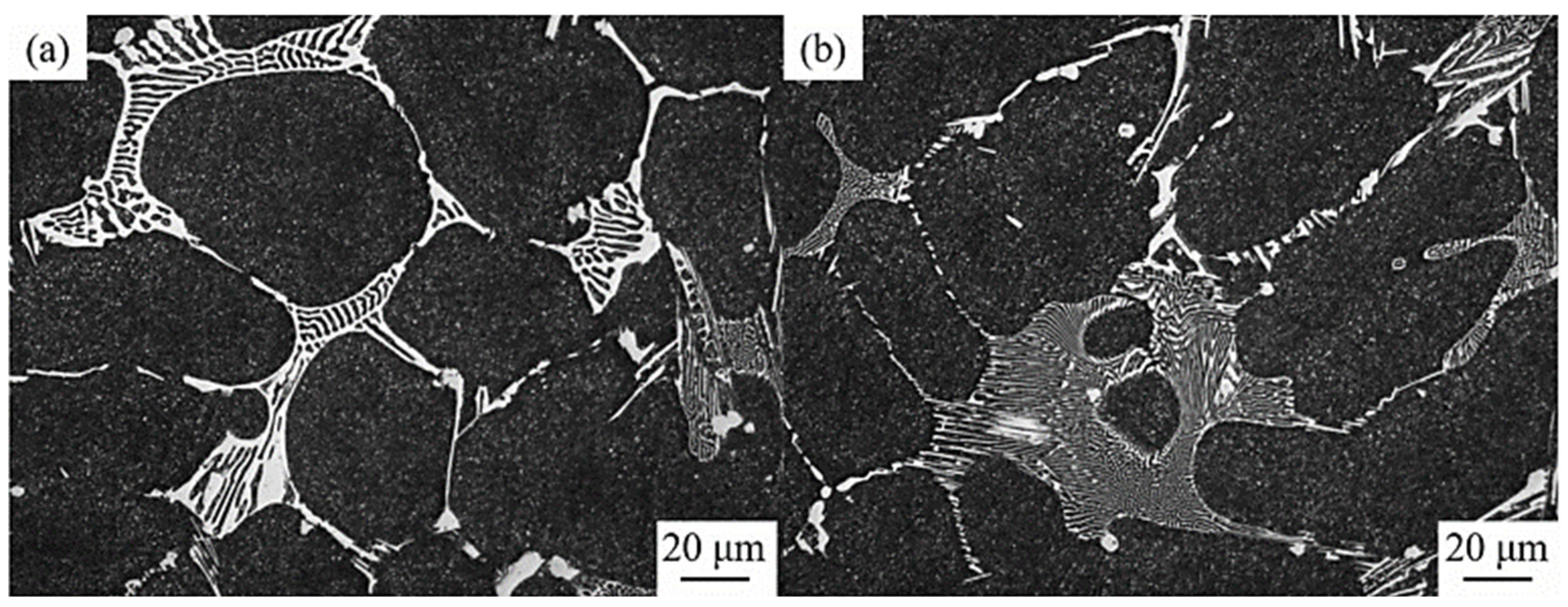
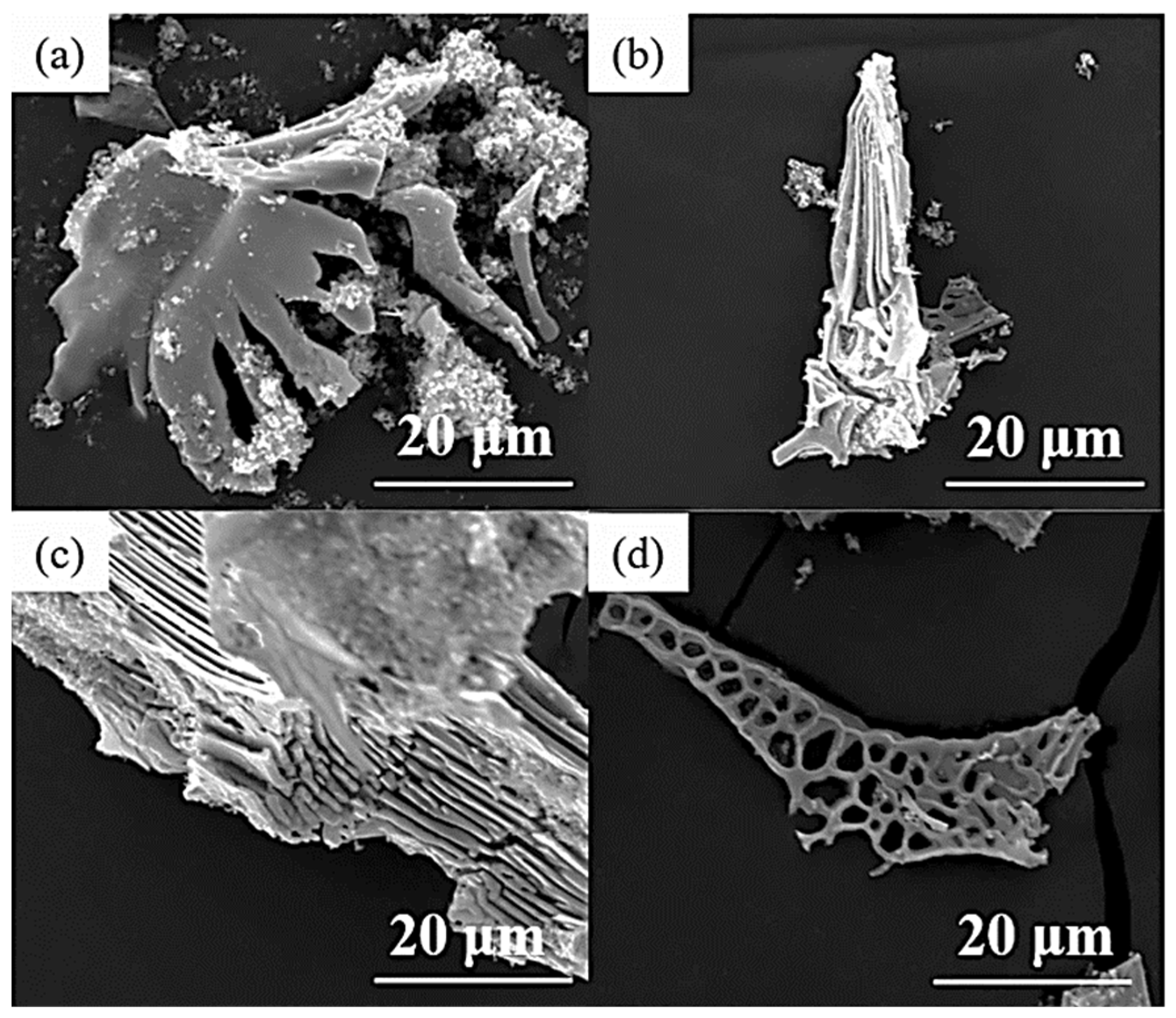
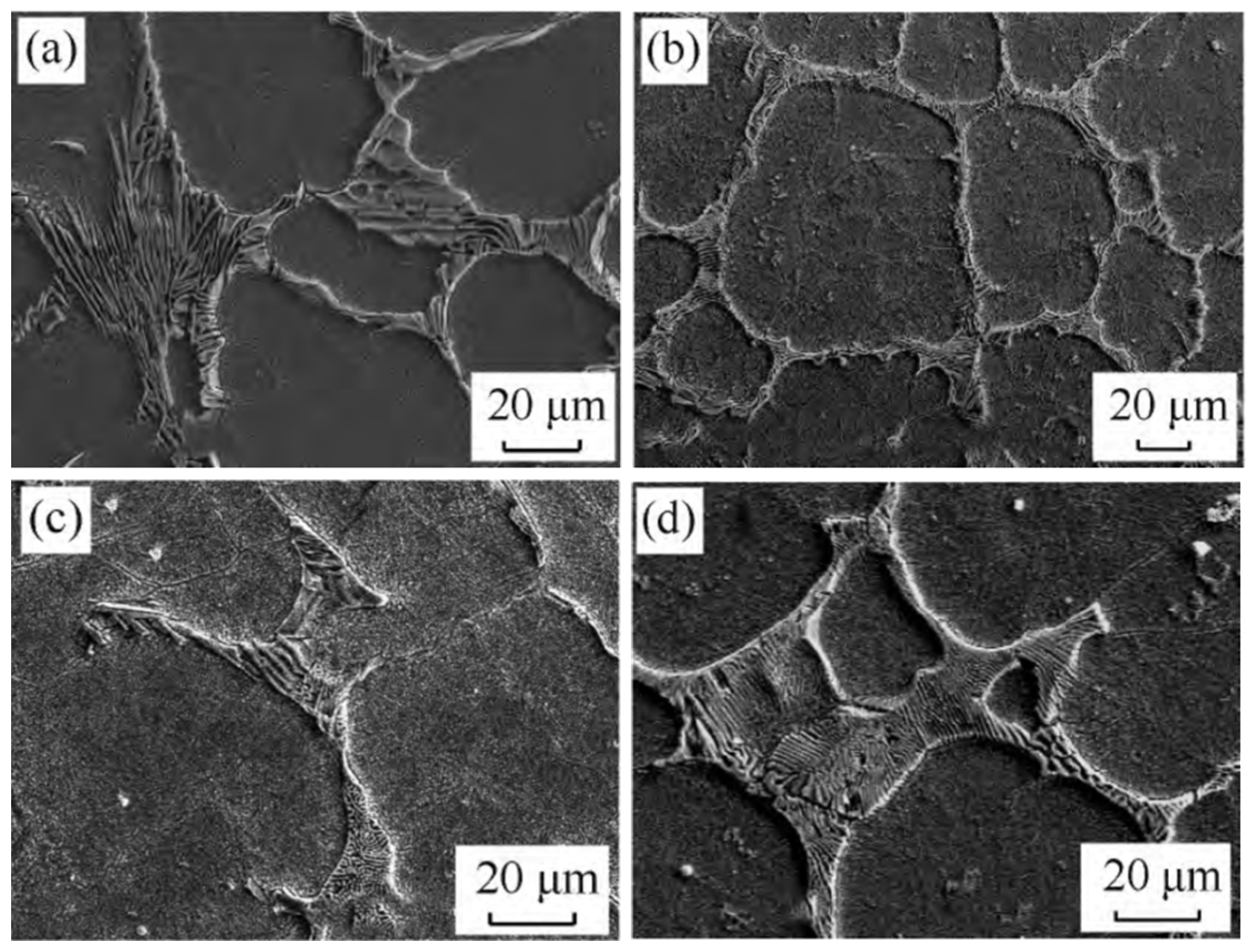
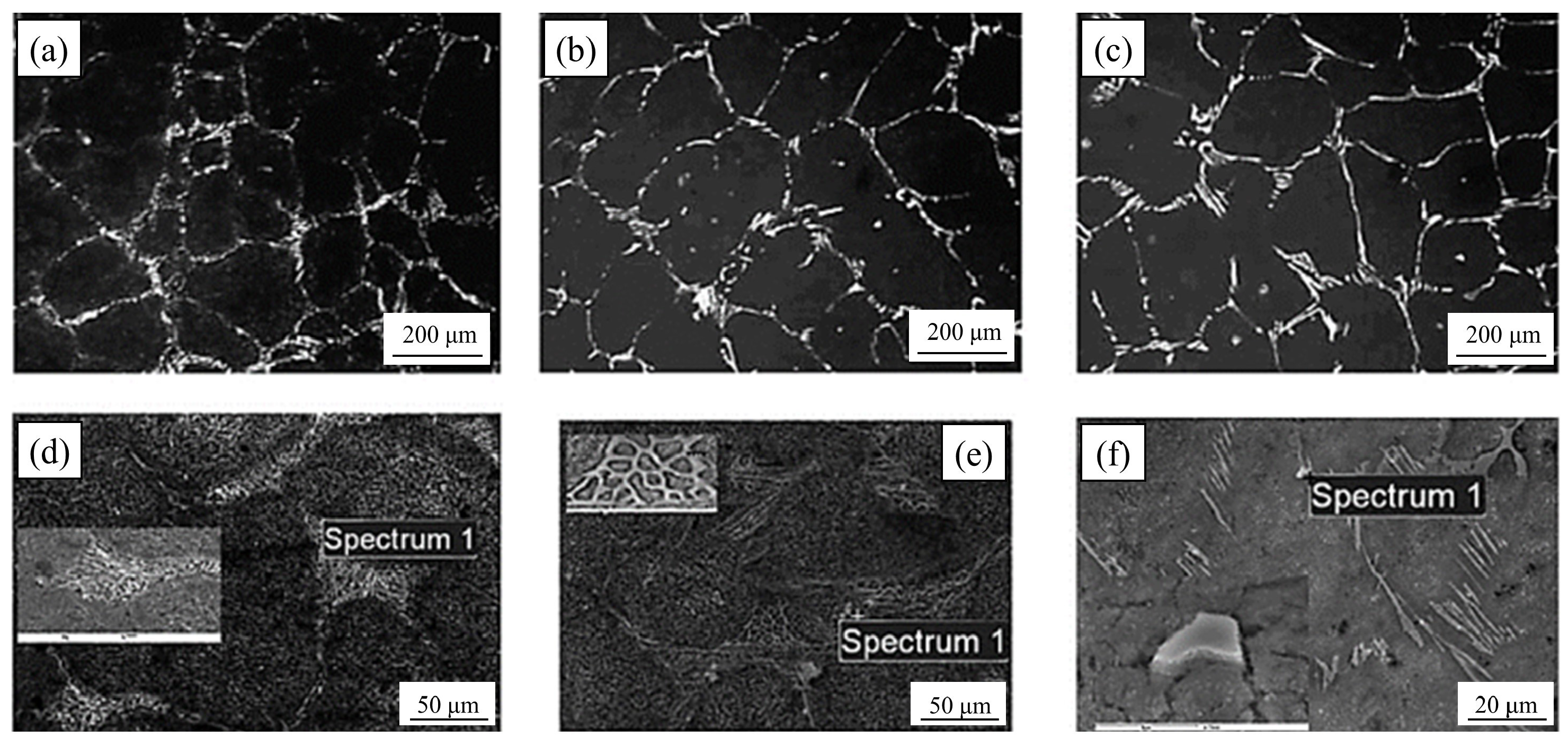
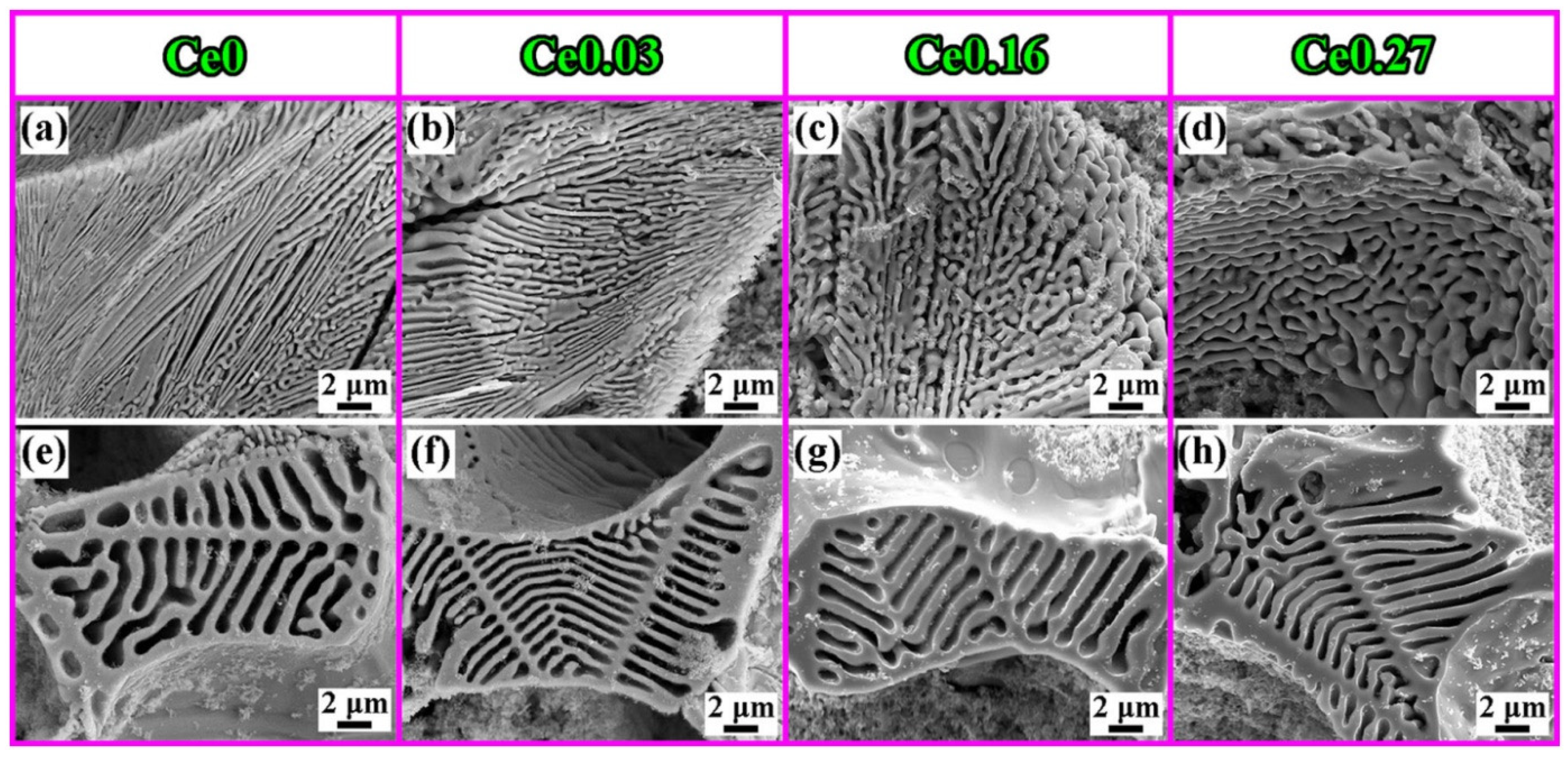

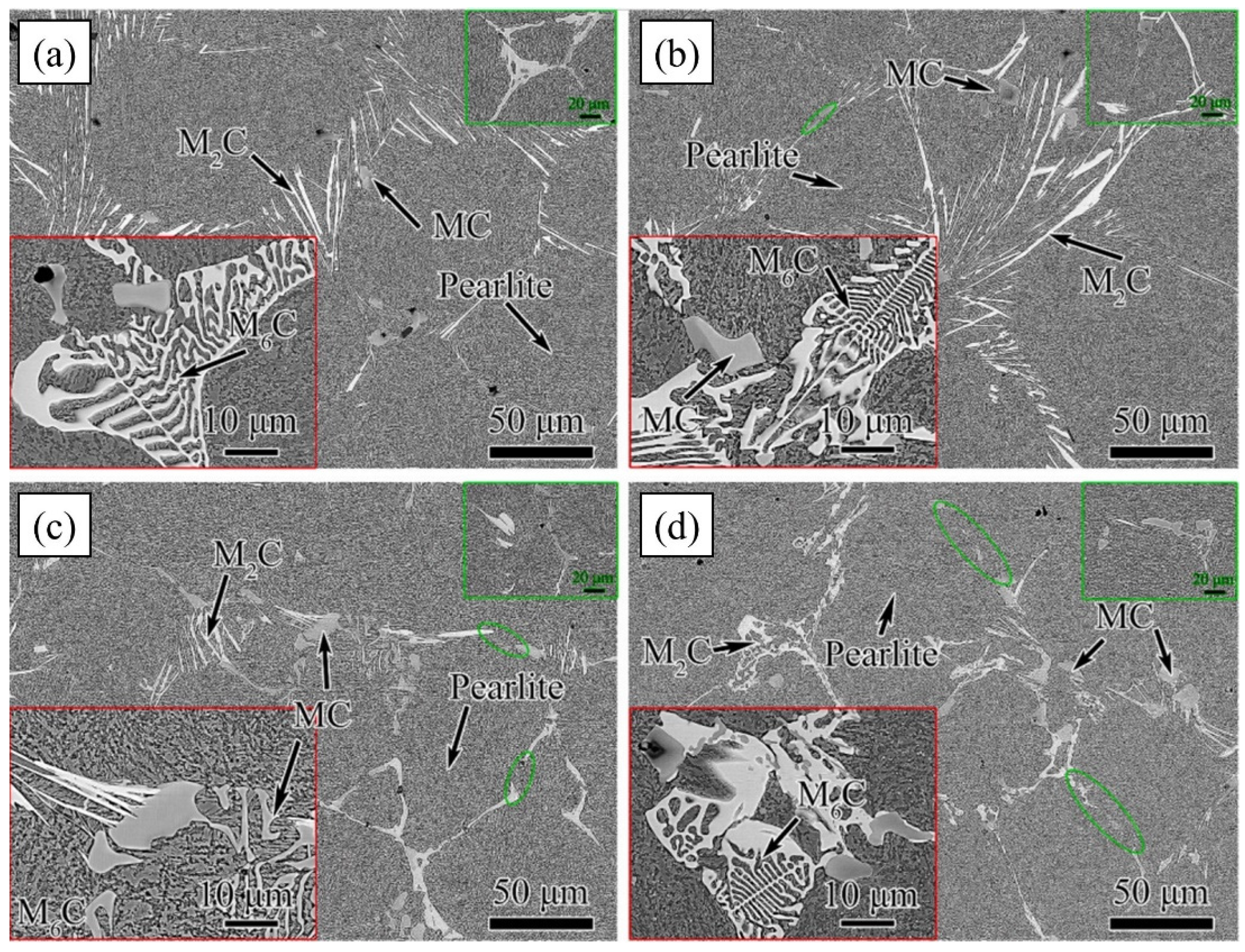
Disclaimer/Publisher’s Note: The statements, opinions and data contained in all publications are solely those of the individual author(s) and contributor(s) and not of MDPI and/or the editor(s). MDPI and/or the editor(s) disclaim responsibility for any injury to people or property resulting from any ideas, methods, instructions or products referred to in the content. |
© 2024 by the authors. Licensee MDPI, Basel, Switzerland. This article is an open access article distributed under the terms and conditions of the Creative Commons Attribution (CC BY) license (https://creativecommons.org/licenses/by/4.0/).
Share and Cite
Chen, Y.; Ye, C.; Chen, X.; Zhai, Q.; Hu, H. Effect of Alloying and Microalloying Elements on Carbides of High-Speed Steel: An Overview. Metals 2024, 14, 175. https://doi.org/10.3390/met14020175
Chen Y, Ye C, Chen X, Zhai Q, Hu H. Effect of Alloying and Microalloying Elements on Carbides of High-Speed Steel: An Overview. Metals. 2024; 14(2):175. https://doi.org/10.3390/met14020175
Chicago/Turabian StyleChen, Yangmin, Chenghuan Ye, Xiangru Chen, Qijie Zhai, and Henry Hu. 2024. "Effect of Alloying and Microalloying Elements on Carbides of High-Speed Steel: An Overview" Metals 14, no. 2: 175. https://doi.org/10.3390/met14020175
APA StyleChen, Y., Ye, C., Chen, X., Zhai, Q., & Hu, H. (2024). Effect of Alloying and Microalloying Elements on Carbides of High-Speed Steel: An Overview. Metals, 14(2), 175. https://doi.org/10.3390/met14020175







